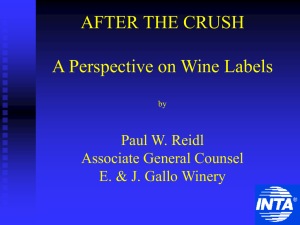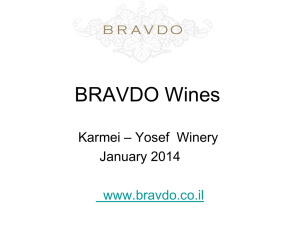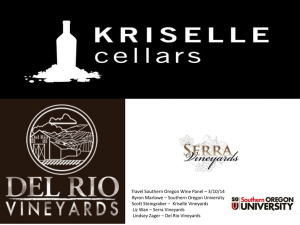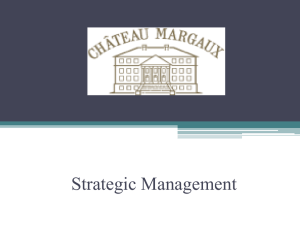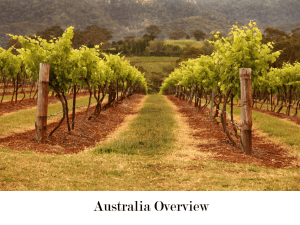Concept of high quality wine
advertisement
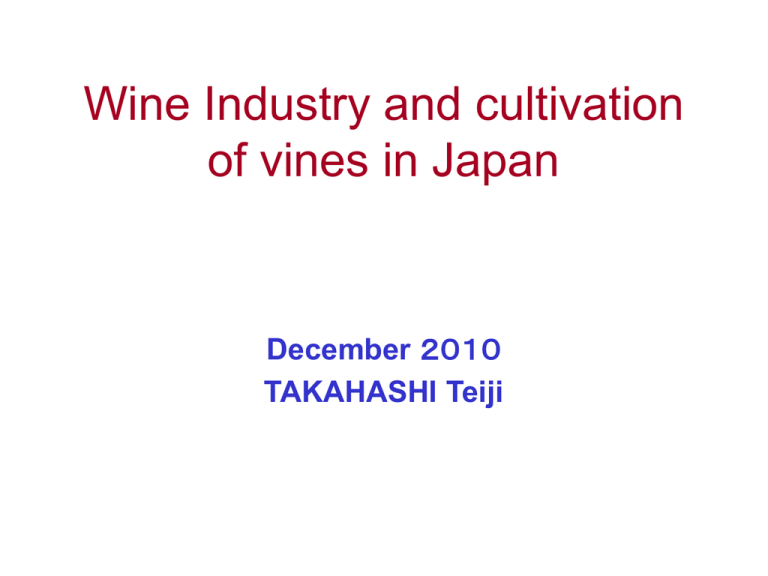
Wine Industry and cultivation of vines in Japan December 2010 TAKAHASHI Teiji History of wine making in Japan Meiji Government encouraged the wine production as a part of the Industry development policy and its failure In 1874 Mita breeding station was established. introduced vines from Europe and the USA , distributed them to many regions in Japan In Iwai village (Yamanashi) a winery was founded. Other wineries were opened. In 1884 Infected by phylloxera In 1890 Zenbei Kawakami started the vinification and cross breeding Meanwhile, the wine was not consumed. Many wineries stopped their business Placing sweetened wine on the market and the expansion of its consumption 1886年 Denbei Kamiya Hati budousyu 1899年 Sinjiro Torii Akadama port wine (Origin of Suntory) During the war, the tartaric acid was needed for radiodetector. The wine making survived. Due to the higher standard of living and the change of eating pattern, the consumption of real wine started in Japan, Triggered by Tokyo Olympic games and by Osaka International exhibition. At first stage, the consumption of imported wine( promoted by activities of women) Production and import of wine National tax agency 1978 1998 2008 Domestic 28 ally produced ,000KL wine 146 83 Imported wine 10 224 163 Total 38 370 246 Supply of wine in Japan (2008) Domestically Produced wine Wine produced by Japanese grapes 10.1% large, medium and small wineries 23.6% Mainly large wineries 25,000KL(15,000 supplied by farmers) Wine produced by imported juice or imported wine 58,000KL Imported wine Table wine 66.3% large, medium and small importers Total 246,000 Par adult 1.9L Quality wine (GI wine) 163,000KL Concentration of wine production Monthly report of statistics of liquors and foods 1997 1998 1999 2000 % Mercian 26.0 25.6 23.2 29.0 Suntory 23.7 22.2 21.5 26.3 Sapporo 9.3 10.2 8.5 9.5 Manns 8.4 9.9 8.5 9.5 Sainte neige 4.6 4.4 5.3 Others 27.5 23.9 20.4 Supply of grapes by farmers Survey of particular fruits by MAFF in 2007 Retrograde development of supply by farmers 2001 02 03 04 05 07 08 Faltering agriculture Hokkaido lower price of grapes (Competition with imported juice) 2390 トン 2326 2200 2252 2403 2282 2373 Yamanas hi 4040 トン 4190 3897 3481 2788 3826 3154 Nagano 3922 トン 2512 3555 2690 4204 4350 4481 Japan total 20184 トン 16509 16779 15360 15002 15838 14865 Increase of production in winery ‘s farming land In winery’s farming land, by contract farming with farmers、 by agricultural organization , Purchase from farmers Recent trend of wine consumption Stable consumption of certain quantity ・・・ Understanding of quality of wine , of related culture ・・・Preference of quality wine Stable consumption of ordinary wine as well Competition with Imported wine Recent trend ・Increasing interest in wine produced by Japans’ grapes (100%) for consumers and producers Remarkable improvement of quality of Japan’s wine for recent 15 years ・Revitalization of older regional wineries and new comers (vignerons) in regions , who are eager to produce high quality Japan’s wine ・In large wineries, strengthening of high quality wine by 100 % of grapes in Japan Concept of high quality wine recent notion ・Quality of wine depends on 80% quality of grapes, 20% technology of vinification ・Good wine is to produce good grapes Wine making is agriculture Wineries themselves , both large and small are eager to produce good grapes. Good grape= sugar and acid high contents, good color and flovour, high contents of mineral, small fruits, thick skin. ・As far as pursuing high quality, character attributed to the region is observed Notion of appellation d’origine (AOC) ・Combination of names of origin and grapes in labelling Conjunction of the notion developed in Europe and the notion developed in the new world Example: Kikyogahara Merlot, Hokusin Chardonnay, Komoro Merlot ・ Possibility of export of high quality Japan’s wine Evolution of production of grapes for wine in Japan ・Belief that climate conditions such as high humidity are unfavorable to the production of vines in Japan Natural features and notion of terroir Technology for production of table grapes has been advanced. ・For many years, the rest of table grapes has been used for wine production. ・Recognition of need of European varieties (vitis vinifera) to produce good wine. Introduction of vitis vinifera and trial of cultivation by large wineries Transfer of technology and know-how to small wineries Selection of suitable land, soil improvement(deacidification, drainage)、 Cultivation methods and management ( trellis training- espalier training, pruning) Prevention of adverse effect of rain ( rain cut, multi) ・Identification that some varieties are possible to cultivate, to produce good wine. Still, under the process of trial and testing, possibility of identification of others varieties ・Reappraisal of indigenous varieties, Kosyu, Muscat-Bailey A, Zenkoji European varieties in Japan Flagship Japan’s wine Kikyogahara Merlot Hokusinn Chardonnay Jounohira cabernet sauvignon Tomi Komoro Merlot Mercian Mercian Mercian Suntory Manns Suitable varieties in Japan Chardonnay、Merlot、Cabernet sauvignon、Petit verdot Hokkaido: Zweigeltrebe、Muller-Thurgau、Kelner Varieties rather difficult, no sufficient experiences in Japan Pinot noir, Rhine reisling, Sauvignon blanc, Shirah Main regions in East of Japan Nagan o ・Shiojiri ・Hokusin ・Toshin ・Matsumoto, Azumino Merlot、Niagara, Concord Chardonnay、 Cabernet sauvignon 、 Merlotー Chardonnay 、Cabernet sauvignon、 Merlot、Zenkoji Cabernet sauvignon 、 Merlot、Chardonnay 、Niagara、 Concord、Kerner Yaman ashi ・Katunu ma, Enzan ・Koufu, Kai ・Hokuto Kosyu、 Cabernet sauvignon 、Muscat bailey A Petit verdot Kosyu、 Merlot 、Chardonnay 、Muscat bailey A, Niigata ・Iwanohara Kosyu、Chardonnay 、 Cabernet sauvignon Muscat bailey A Yamag ata ・Kamino yama, Zao Cabernet sauvignon 、 Merlot 、Chardonnay 、 Black queen, Pinot noir、Muscat bailey A Hokkai do ・Yoichi ・Otaru ・Tokachi Muller thurgau、Kerner、Zweigeltrebe、 Baccus、Delaware Kiyomi, Yamasati、Kiyomai、 Zweigeltrebe、 Main production areas of large wineries Mercian Kikyogahara Nagano Merlot Hokusin Nagano Chardonnay Jyonohira (Katunuma) Yamanashi Cabernet sauvignon Omori Akita Reisling (3ha) Niizuru Fukushima Chardonnay (40,000 bottles) Mariko Nagano Chardonnay, Sauvignon blanc、Merlot (release in 2010) (12ha, old mulberry field (derelict field)、 rain 900mm) Suntory Tomino-oka Yamanashi Tomi (150ha, Altitude 400~600m) Shiojiri Nagano Shinsyu Chardonnay、Kikyogahara Merlot (10ha) Manns Komoro Nagano Merlot、Chardonnay (4ha, contract farming10ha) Higashiyama Nagano Cabernet sauvignon (3.3ha altitude 500m rain 950mm) Wines of 100% Japanese grapes by larges wineries Mercian Release of Mariko wine from 2010 Suntory Japan premium (Thrilling Japanese wine in the world) from 2010 100% domestic grapes, Series of regions, Shinsyu, Shiojiri、Tugaru、Kaminoyama, Azumino 100% domestic grapes, Series of grape varieties Muscat bailey A, Kosyu, Chardonnay, Merlot Manns Solaris series Komoro Chardonnay、Shinsyu Chardonnay、Komoro Merlot Thikumagawa Merlot、 Shinsyu Cabernet sauvignon, Higashiyama Cabernet sauvignon Example of medium and small wineries Takeda winery Yamagata Kaminoyama 15ha Cabernet、Merlot、Chardonnay、Reisling、Muscat bailey A Ofuse winery Nagano 5ha Chardonnay 5,000 bottles、Merlot 5,000bottles Iwanohara wine Niigata 10ha Muscat bailey A, Black queen Hayashi farm Goiti wine Nagano 7ha, 38 farmers in contract Special red、Gold red、Concord without additives、Niagara Izutu wine Nagano Merlot barrel fermented、Cabernet barrel fermented Misawa winery(Tyuou budosyu) Yamanashi, 8ha ( old mulberry field ), Cabernet, Merlot, petit verdot, 4ha Kosyu Beau paysage、Tsugane Yamanashi 2.8ha Cabernet, Chardonnay, Merlot Sakaori winery Yamanashi , Mainly by contract with farmers Muscat bailey A Around half of prizes in Japan wine competition were given to wines of small and medium size wineries in 2010. All over Japan, approximately 200 wineries in 2010 Cultivation method of vines in Japan (Control of growing environment) Limitation of fertilizer and pesticides (Control of growth) Prevention of much growth Leaf thinning、pruning、摘芯、espalier training、 high density planting (3,000~6,000/ha) (High density planting and control of yield) Two branches (arcures), 10~15 buds (yeux)、one cluster par bud Restriction of yield (5~15 tonnes/ha), Kosyu table grapes: 17 tonnes /ha) Distance between pieds :1~1.5m、distance between line (row) 2~3m (Prevention of humidity (rain)) Problem of rain in fall: rain cut, multi (Prevention of diseases) Green house effect to grapes • Problems of color and sugar contents for black grapes problems of sugar contents and flavor for white grapes • According to recent studies, certain level of low temperature is important, instead of the difference of temperature between day time and night. Above 25 degrees in night = the sufficient black color does not come. Without low temperature in night and at dawn= the level of sugar contents is insufficient. • ・ Pionet (table grape) : no sufficient color. Kyoho (table grape) in Makioka district : insufficient color in recent years. • In Kikyogahara, suffering from diseases in recent years. Irregulier rains. However, color problem does not exist. The cultivation of cabernet became possible in recent years.(Izutu wine grows this variety) • Diseases became serious under the greenhouse effect. Tokachi areas (Hokkaido) are suffering, due to the high humidity in summer. 30 % were infected by mildew in Yamanashi prefecture (2010) Kosyu and Muscat bailey A have been suffering from diseases (2010) Green house effect (Continued) • Chardonnay in a winery in North Nagano has been totally devastated, because of missing of timing of spraying (2010) • Niagara is cultivated all over Japan. In Yamanashi, the aroma are poor. No problem in Kikyogahara for Niagara and Concord. • The flavor of Chardonnay is the most intensive just before sun rise. The wine in Kumamoto (Kyusyu) has won a gold prize. Grapes were harvested at dawn. • The production of good wine would be possible in western part of Japan by selection of suitable land at high altitude. • Opinions that too much concerns about the greenhouse effect would induce a confusion, in longer terms. Institutional issues of wine production and consumption ・Liquor tax law regulates the wine only for the purpose of imposition of tax. Any specific legal definition of wine does not exist ( Fruits liquor) ・There is not any legislation for wine industry development, neither for the protection of consumers. ( A group of parliamentarians of the liberal democratic party for the development of wine industry has been created. ) ・No legal standards for the labelling (Voluntary standards by some groups of the industry exist) ・The system of GI (regional collective trade marks, GI system under the law of cooperatives for liquor) does not function well. There is not any registration・ designation for wine at the moment. (In the world standard, high quality wine is legally segregated from usual wines) ・No legal system to classify the domestic high quality wine as GI ・Japanese high quality wine is regarded as ordinary one in overseas market. =labelling of names of region , of 「barrel fermented」, 「 sur lie」 are not allowed in overseas。 ・ Uncertainty of protection of names of Japanese high quality wines Appellation d’origine management system in Nagano (since 2002) Requirements of production ・Grape varieties and sugar contents Merlot, Chardonnay, Asama merlot = sugar contents over 19 degrees Other varieties are classified according to the minimum degrees of sugar contents(18, 17,and 16 degrees) ・Grapes produced in Nagano prefecture 100% ・ Blend of varieties Yes ・Limit of enrichment (Chaptalisation) 19 degrees maximum limit of alcohol value of enrichment 3.15ml/100ml 18 degrees 3.80 17 degrees 4.46 16 degrees 5.10 Degree of sugar contents of grapes Acidification, Deacidification No Appellation d’origine management system in Nagano (Continued) ・Juice reserve Yes (under 25% of the wine) ・Freezing of grapes Yes ・Blend of different vintage wines No ・Additives sulfite only Noble wine and wine of frozen grapes Other wines Under 350mg/kg Under 250mg/kg ・Place of vinification From crush to bottling and bottle aging within the territory of Nagano prefecture ・Sensory test (examen organoleptique) Obligation ・Labelling standards ・Surface side Registration mark ・Reverse side Name of origin (Nagano)、Name/s of varieties ( percentage)、 Vintage year、Place of production, Name of additive (sulfite) Certification system of appellation d’origine of Kosyu city(2010) 1 Categories (1) Wine of grapes produced in Kosyu city 100% of grapes harvested in Kosyu city Sugar contents: Kosyu: minimum 16 degrees、European varieties: minimun 18 Hibrid varieties: minimum 17 Bland of different varieties is allowable, except Kosyu variety (2) Wine of grapes harvested in Yamanashi prefecture, Vinification in Kosyu city 100 % of grapes harvested in Yamanashi Sugar contents: same standards as above 2 On site verification based on application document by the committee of document examination (by November) 3 Application and Examination by the Committee of document examination 4 Sensory test by the committee of sensory test 5 Examination of labelling 6 Declaration of certification、 Distribution of certification sticker
